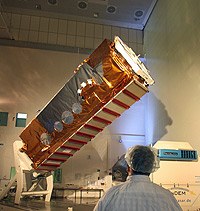The countdown has started!
The satellites TerraSAR-X and TanDEM-X are two 'radar eyes' that operate in a part of the electromagnetic spectrum that is invisible to the human eye. This is known as the microwave region (the wavelength is 3.2 centimetres), and it is here that devices such as walkie-talkies, mobile phones, WLAN and microwave ovens all work. The great advantage of microwaves is their ability to penetrate cloud cover almost effortlessly – that is, radars can almost ‘look right through’ clouds. The reliability of image acquisition is the reason we dare to aim for this mission’s ambitious objective: to produce an accurate digital terrain model of the entire surface of planet Earth in the space of just three years. The aim is to produce a terrain model with a data point spacing of twelve metres and altitude measurements accurate to within two metres.
The procedure for recording the third dimension, the different terrain heights, has been around for a long time and is known as interferometry. The satellites will form an interferometer by flying in close formation and acquiring images of the same terrain from slightly different perspectives. The difference in radar signal transit times between each satellite and the ground can be extracted in a first step by the pixel-by-pixel overlay of the images, which include transit time or phase information as well as the backscatter intensity. In a second step, the height of the pixels is calculated, providing data for the digital terrain model. The principle is simple enough but as always, the devil lies in the detail and a veritable mountain of technical challenges need to be surmounted before this highly ambitious mission objective can be accomplished.
Exciting challenges

It's clear that formation flying is by far the most exciting challenge, since the satellites will converge to within 200 metres of one another – at a speed of 28,000 kilometres per hour! Colleagues from flight dynamics who are responsible for control of these satellites and for orbit management will step centre stage no later than a month after the launch, at the point where the satellites initially converge to within 20 kilometres of one another and then, two months later, will be guided to their final formation. However, mission planning, a logistical task, also needs to be mastered. By this we mean the planning of image acquisition, management of satellite resources such as available memory space, downlink capacity, battery status, thermal budget and many other parameters, all of which require close scrutiny. This has to be accomplished in close cooperation with the fine-tuning of the radar instruments that, on the one hand, must deliver optimum image quality and, on the other hand, need to work synchronously with one another – that is, one satellite transmits while both receive the resultant echoes. It is not until both satellites come within range of a ground station that they are able to downlink their stored imagery; they will transmit the image data to the ground station, thereby creating space for new images. On the TanDEM-X mission, to achieve optimum utilisation of the satellites, a global network of three ground stations is being operated.
Following receipt of the data, these are turned into images, which are in turn processed into digital terrain models. The expected volume of data is 1300 petabyte (1 petabyte equals 1,000,000 gigabytes) — for data on this scale for which appropriate infrastructure needs to be provided. Finally, all operational processes need to be perfectly matched and to mesh as seamlessly as the cogs in a machine.
At this time, TanDEM-X is still at IABG, a company based in Ottobrunn, near Munich. Here, tests have been being conducted to simulate space conditions, as well as vibration and acoustic tests. Data link trials have also been conducted to ensure that the satellite can communicate effectively with the control centre in Oberpfaffenhofen. Now however, over the next few days, TanDEM-X will be packaged in a special container ready for shipment and, on 11 May 2010, it will leave Munich Airport en route for Baikonur in Kazakhstan. My colleagues and I are keen to share more information about forthcoming events on this blog as soon as they occur. We look forward to your visit!
Top image: Twin satellites TanDEM-X and TerraSAR-X orbiting Earth at a short distance from each other. Source: DLR.
Bottom figure: TanDEM-X was built in a public-private partnership between DLR and the European space company Astrium, based in Friedrichshafen. Source: Astrium.
Tags:
